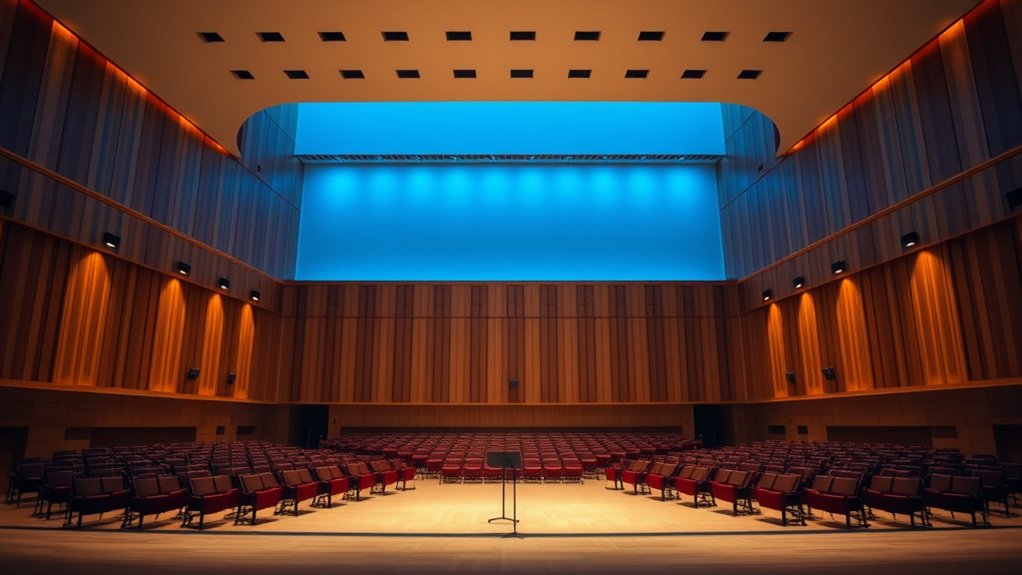Lyricless storytelling with sound relies on melodies, textures, and environmental cues to create vivid narratives without words. You actively interpret layered sounds and silence, filling in story gaps with your feelings and imagination. As the soundscape evolves, it evokes emotions, setting scenes, and building tension or relief. Each element guides your emotional journey, making the story uniquely yours. Stick around, and you’ll discover how sound crafts powerful stories beyond words.
Key Takeaways
- Instrumental music uses layered melodies and textures to evoke emotions and guide imagination without words.
- Soundscape evolution creates a dynamic narrative, shifting environments and moods over time.
- Instruments and sound changes depict settings, characters, and actions, forming vivid mental imagery.
- Transitions and specific sounds seamlessly move the story through different scenes and emotional states.
- Sound design and genre choices craft immersive atmospheres, conveying complex stories without lyrics.

Sound has a powerful way of telling stories without the need for lyrics or words. When you listen closely, you can see how instrumental narratives unfold, guiding your emotions and imagination through layered melodies and textures. This form of storytelling relies solely on sound, allowing you to interpret the story in your own unique way without the constraints of lyrics. As the music progresses, you become an active participant, filling in the gaps with your personal experiences and feelings. It’s a dynamic conversation between the composer and you, where every note and silence carries meaning.
One of the most fascinating aspects of lyricless storytelling is the soundscape evolution. You notice how the environment created by different sounds shifts over time—whether it’s a gentle wave of ambient noise that gradually intensifies or a sudden burst of rhythm that signals a turning point. This evolution of soundscapes helps you understand the narrative’s progression, evoking feelings of anticipation, tension, or relief. Each sonic element plays a role in shaping the story’s mood, pulling you deeper into its world without ever needing words to clarify what’s happening.
You can think of instrumental narratives as a form of visual storytelling, but instead of images, the story is painted with sound. The way instruments interplay, change dynamics, and layer over each other creates a vivid mental picture. When the tempo accelerates, it might mirror rising action or excitement, while a slow, sustained note could evoke reflection or sorrow. The soundscape’s evolution guides your emotional journey, making you feel the story’s highs and lows without any lyrics anchoring the meaning. It’s a pure experience, where your imagination fills in the story’s details, shaped entirely by the sound design.
You might also notice how composers craft these soundscapes to evoke specific settings or moments. For example, a shimmering chime might suggest a mystical forest, while deep bass tones could hint at an ominous presence. As the soundscape evolves, it can transport you from one scene to another, creating a seamless narrative flow that’s both immersive and intuitive. This approach empowers you to interpret each sonic cue, making the story uniquely yours. In lyricless storytelling, the focus is on the power of sound to communicate complex emotions and stories, proving that words aren’t always necessary to tell a compelling tale. Additionally, understanding music genres can enhance your appreciation of how different sound elements are used to evoke specific narratives and moods.
Frequently Asked Questions
How Does Sound Evoke Emotional Responses Without Lyrics?
You can evoke emotional responses through sound without lyrics by leveraging instrumental emotion and sound symbolism. Instrumental music uses melodies, harmonies, and dynamics to express feelings directly, while sound symbolism connects specific sounds or tones to particular emotions. By carefully choosing these elements, you create a powerful emotional impact that resonates with your audience, allowing them to feel joy, sadness, or tension even without words guiding their interpretation.
What Are the Key Techniques for Effective Lyricless Storytelling?
You master lyricless storytelling by leveraging musical motifs and ambient textures to craft emotional depth. Use recurring motifs to create familiarity and emotional resonance, while ambient textures set the mood and atmosphere. Dynamic shifts in volume and tempo can heighten tension or release, guiding your audience’s feelings without words. Keep your sound design precise and intentional, ensuring each element enhances the narrative’s emotional journey with striking clarity.
How Do Different Cultures Utilize Sound in Storytelling?
You observe that different cultures utilize sound in storytelling through instrumental traditions and storytelling rituals. For instance, African drumming and Indian classical music serve as storytelling tools, conveying emotions and narratives without words. Indigenous rituals often incorporate specific sounds to connect communities or honor ancestors. By engaging in these practices, you experience how sound becomes a powerful, universal language, transcending spoken words to evoke shared cultural stories and deepen collective understanding.
Can Sound Alone Create a Sense of Narrative Progression?
Yes, sound alone can create a sense of narrative progression. You can use instrumental motifs to evoke emotions and sonic symbolism to represent characters or themes, guiding your audience through the story. By carefully layering sounds and motifs, you build tension, resolution, and movement, making the story feel dynamic. This approach taps into your listeners’ instincts, allowing them to follow the narrative without words, through the power of sound alone.
What Technology Is Essential for Producing Lyricless Sound Stories?
You need essential technology like advanced audio engineering tools and innovative instruments to produce compelling lyricless sound stories. Instrumental innovation enables you to craft unique sounds that evoke emotions and narrative flow. High-quality digital audio workstations (DAWs) allow precise editing and mixing, while professional microphones and speakers guarantee clarity. Combining these tools helps you create immersive, storytelling soundscapes that engage your audience without relying on lyrics.
Conclusion
As you listen closely, it’s funny how the sounds you didn’t plan seem to perfectly mirror the story unfolding in your mind. Sometimes, a distant bell or a faint whisper appears just when you need it most, as if fate itself is guiding your imagination. That coincidence keeps you hooked, reminding you that even without lyrics, sound has a way of weaving stories that feel just right—like they were meant for you all along.










